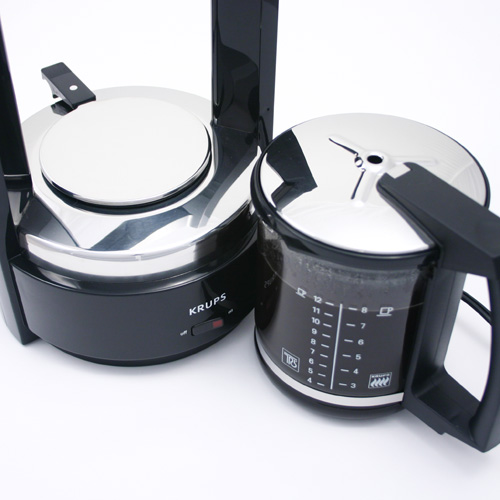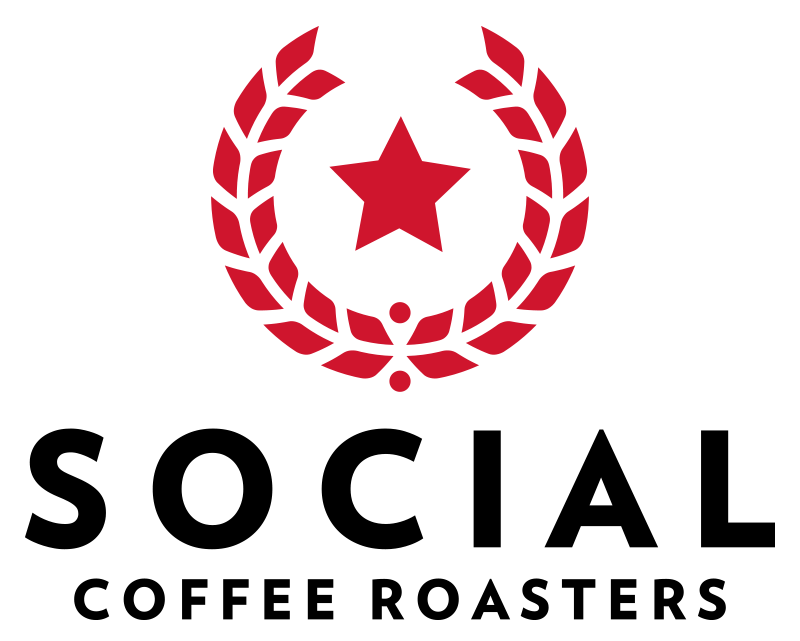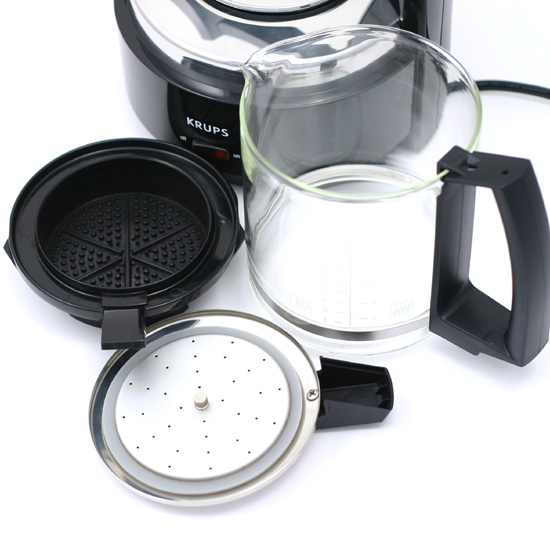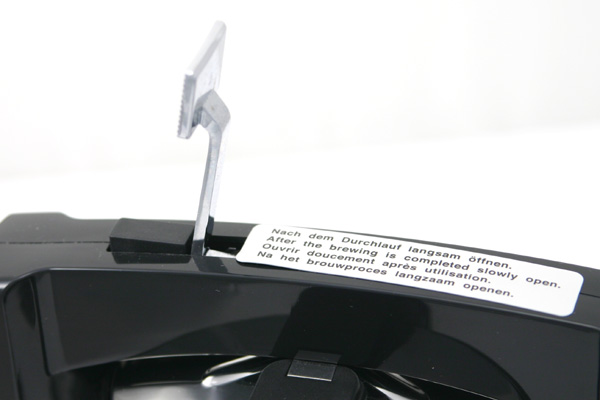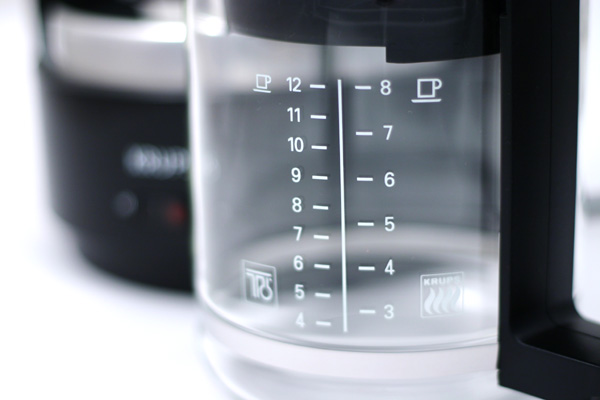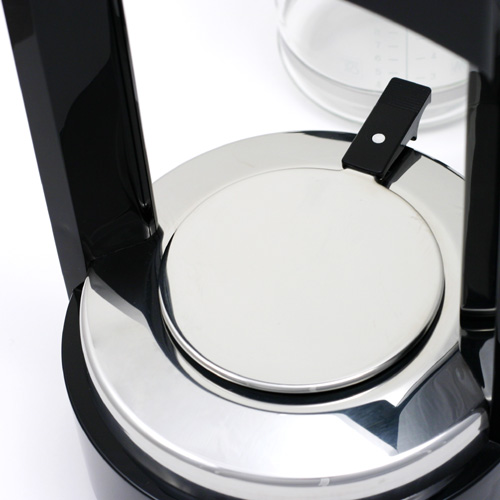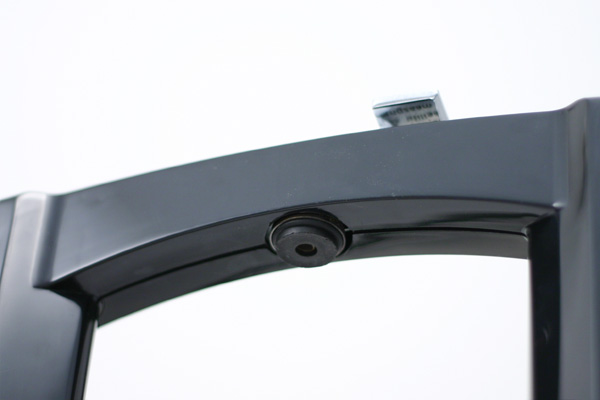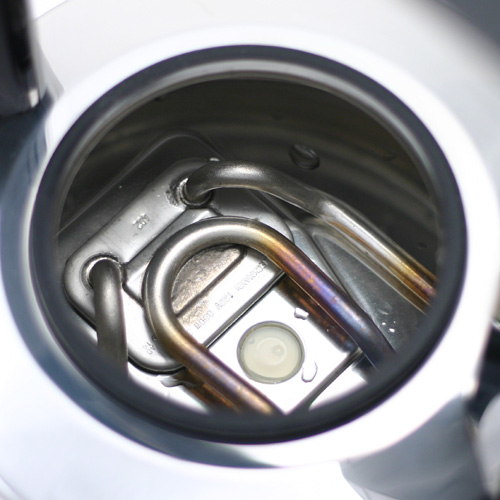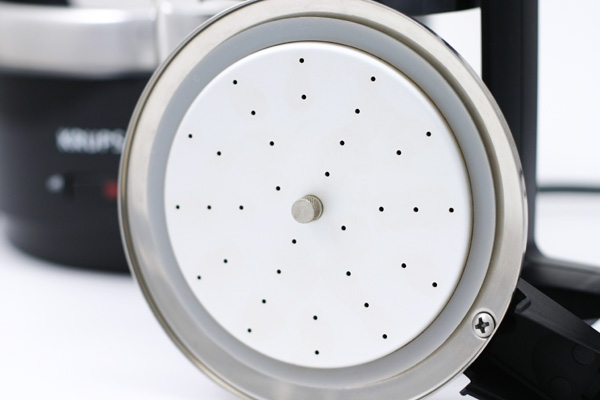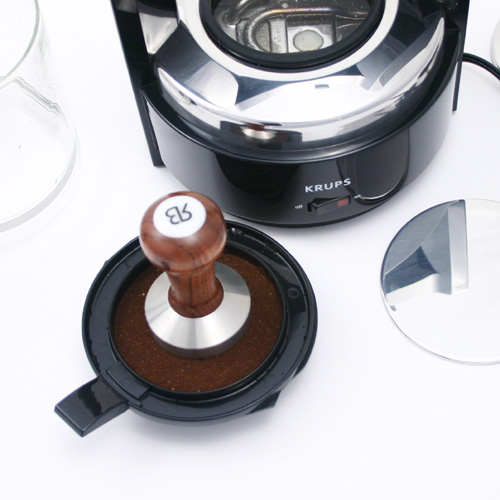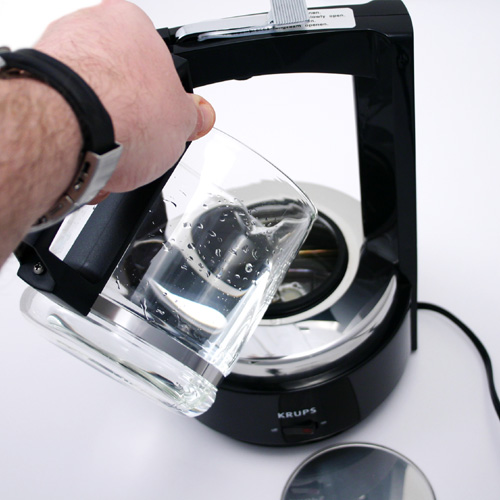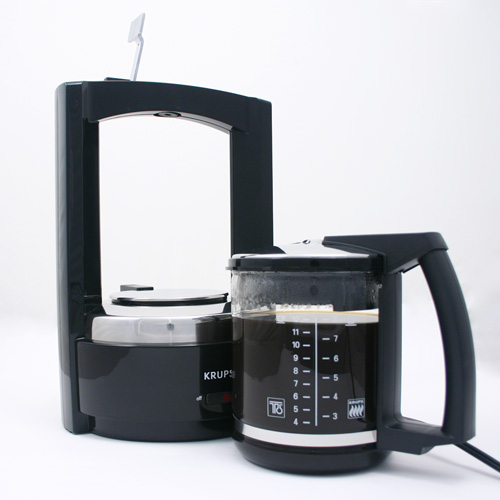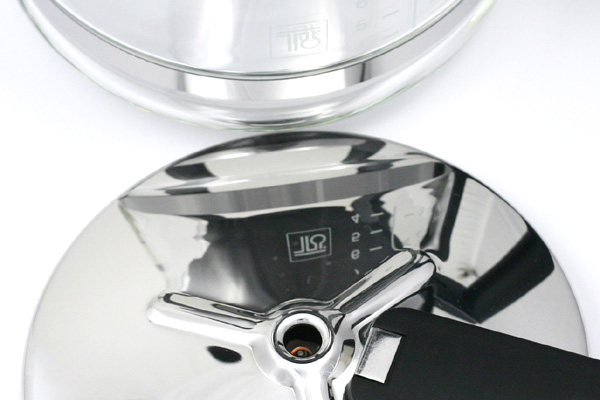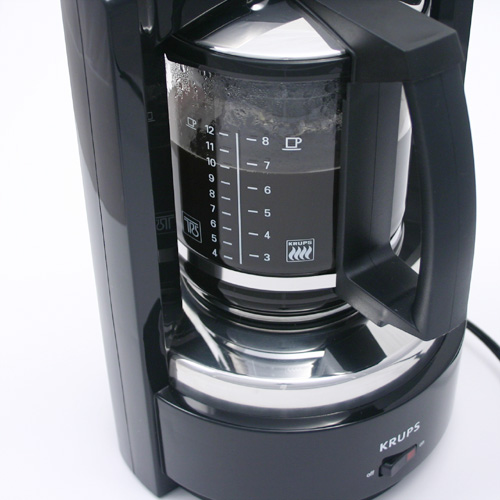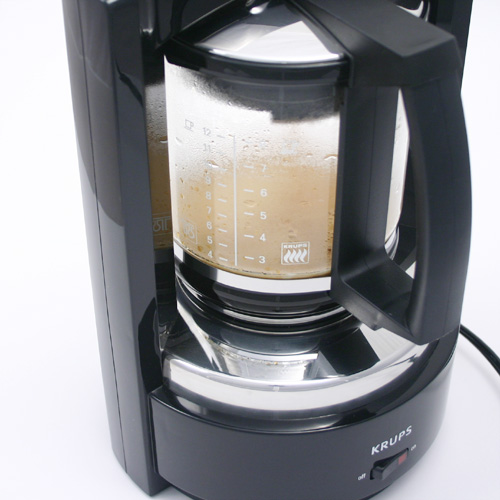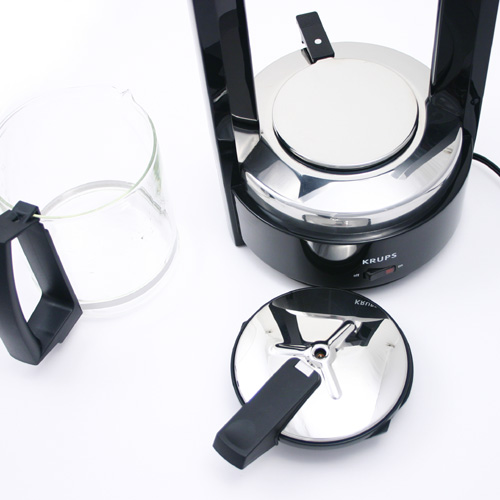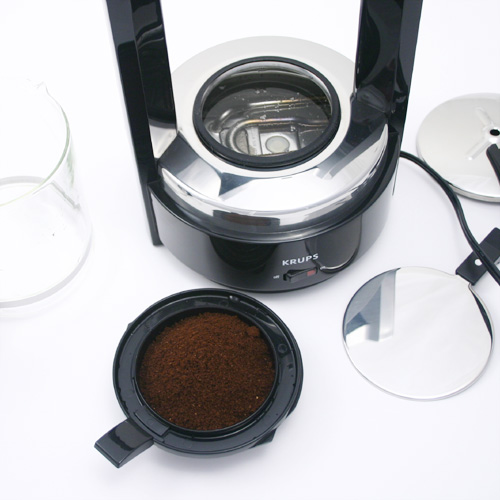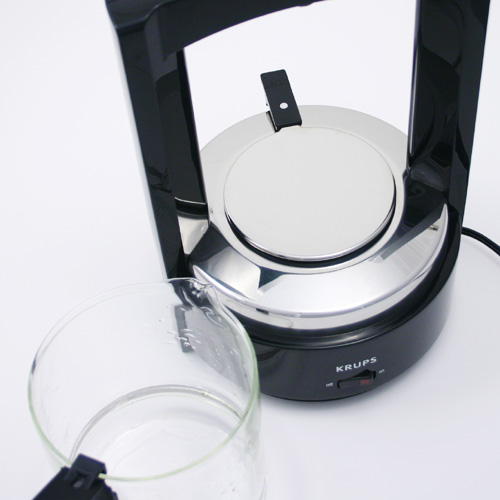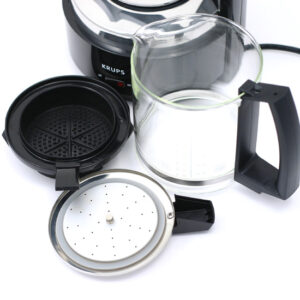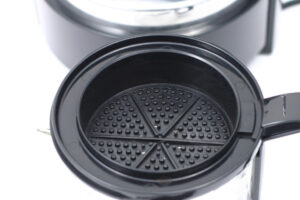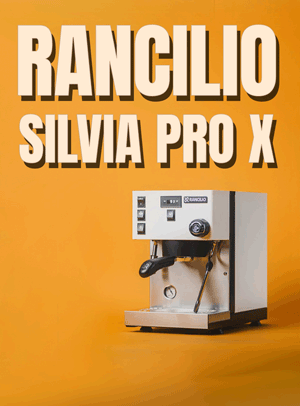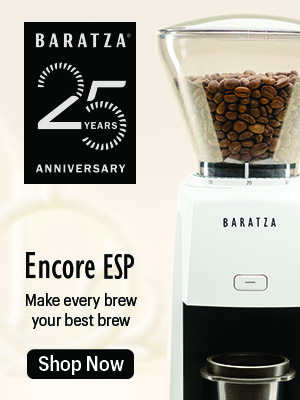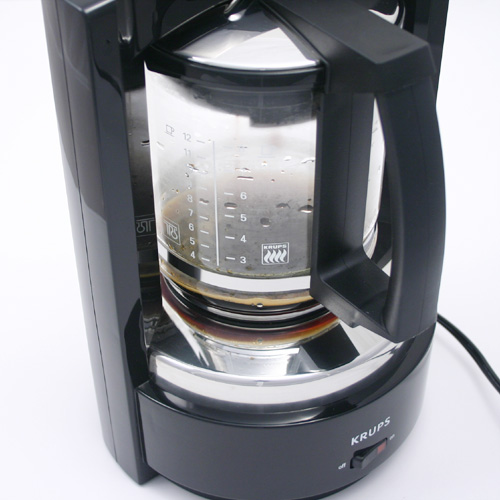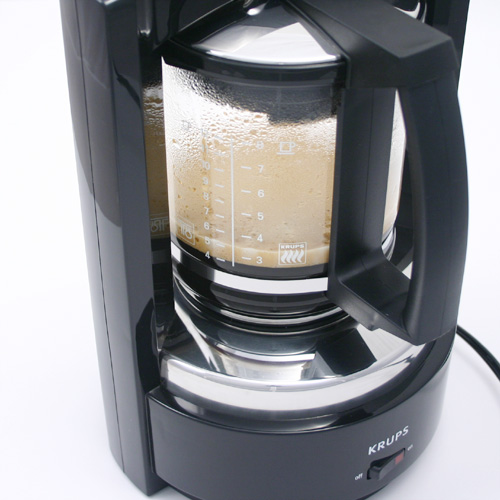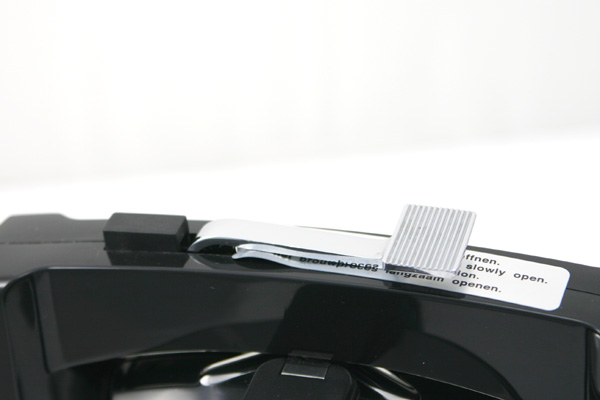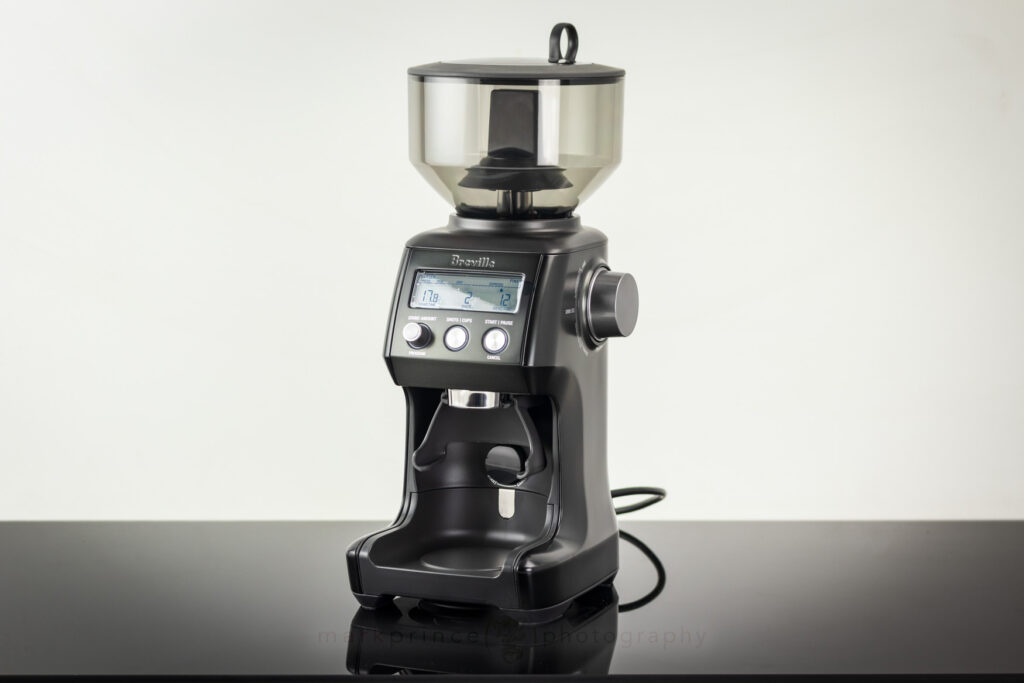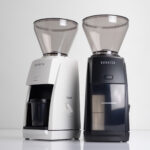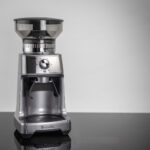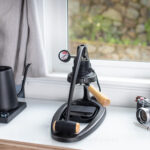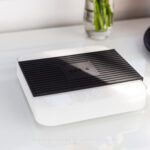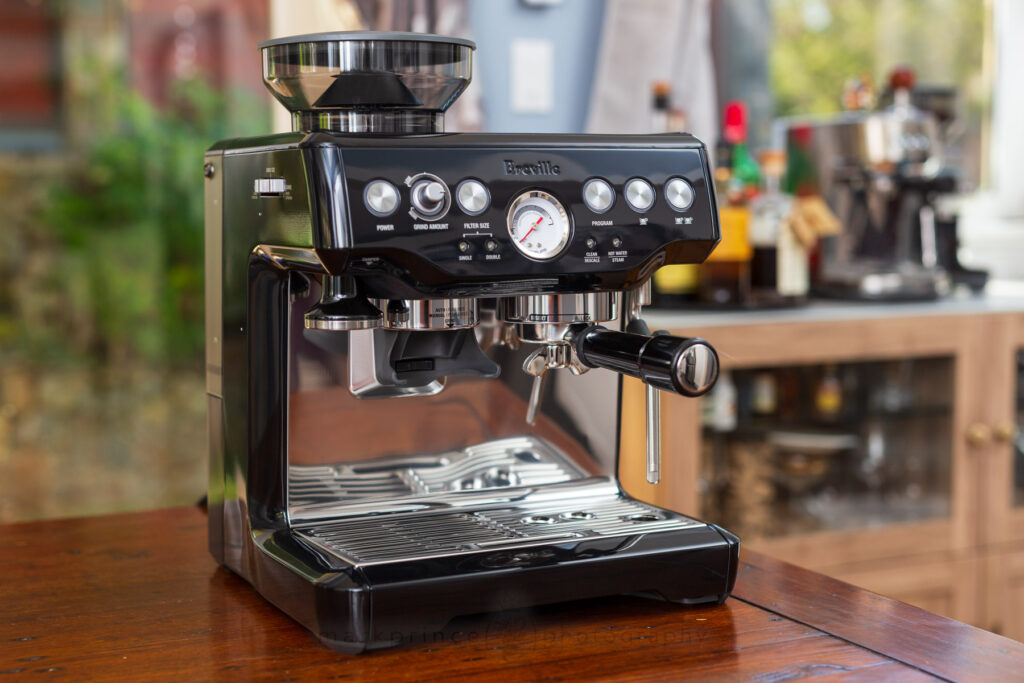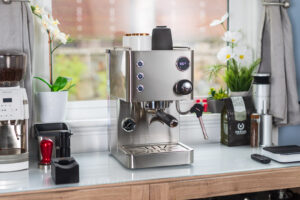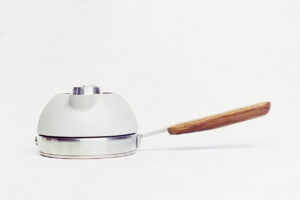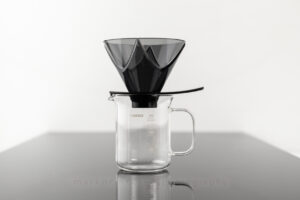-
A completely unique way to brew coffee: like a moka pot, but large batches
-
Very simple in operation, but also very well built, designed to last.
-
Quiet, and relatively quick in operation.
-
Looks good and occupies a small footprint on your counter
-
Parts are still available for it, even though it is long discontinued in the USA.
You walk into a local drug store and you see it: another Krups coffee brewer.
The Coffee Newbie goes “wow, looks great! Krups sure does make great stuff!”.
The Coffee Geek goes “hrmph, another Krups brewer. All style no substance. Surprising though, there’s no timer and built in grinder…”
What’s interesting about these situations is that, in the case of the subject for this first ever QuickShot review, the Coffee Newbie is closer to the truth than the Coffee Geek.
Blame it on Krups. Always a company that could design awesome looking products with lots of buttons and readouts and glass and chrome, they always end up a bit short in the substance department: every single Krups coffee brewer that we’ve put under the Fluke temperature tests has come up short – as much as 20F short. Until today at least.
One thing to realise is that we’re not just talking about a typical Krups brewer here; nor are we talking about coffee maker that simply brews at the right temperatures. We’re talking about a new brewing method; one that is new to North America at least. We’re talking about a pressure brewing coffee system that borrows from both the auto drip world, and the moka pot world. We’re talking about the Krups Moka Brew.
We received our Krups Moka brew in late August and right away, a few things seemed a bit different. Yes, the box was full of images and graphics, but it didn’t seem the same as other Krups products as of late. I’m talking both the packaging and the product inside.
Unpacking it was a simple affair. It was double boxed when shipped to us and this is standard – it arrived safe and sound, something we always like to see at the CoffeeGeek lab. Inside you’ll find the brewer, an instruction booklet (no video!), the filter assembly and lid, and a box of round filters.
Right off the bat, I gotta say I like the look of this product. I think it looks classy as heck, and it’s surprisingly small (or large… one of my testers said that, based on photographs he saw of the brewer, he expected it to be half the size). The product’s base is circular, with a diameter of 19.8cm (7.75″) at the widest point. The unit has a “base” of sorts that’s about 11cm (4.25″) tall, and two black columns stretching up 29cm (11.5″) from the countertop. With the arched curve of the material spanning the two columns, the entire unit is about 31.5cm (12.5″) tall with the top lever closed (34.5cm, or 14.5″ when open).
The Krups Moka Brew weighs 1.08kg (2lb, 6oz) without the carafe, and 1.65kg (3lb, 10oz) with the carafe.
The unit at first glance doesn’t have a lot of “gizmos” – all you see at first is and on and off switch. Once you look up top you’ll notice something else – replete with warning stickers, there’s a lever and a push button. I’ll talk more about this in the operation section.
When you remove the carafe you notice the base it sits on is a relatively simple metal disk with a plastic handle off one side of it. The carafe itself looks unassuming at first, but it’s actually a complex affair, made up of two portions – a metal top that acts as a water intake and water dispersion screen, and a plastic “well” of sorts that is the filter and ground area.
They fit together quite easily and naturally which is a testament to the product design – there’s very little chance you won’t assemble this properly. The Carafe easily slots into the machine, if you place it into position the proper way. You have to press button on the top of the machine and lift the lever first.
Then slot the carafe into place – plastic nibs on the side of the unit rest against the columns ensuring it is in the proper position. You lock down the lever and voila, you’ve set the machine up and you’re ready for some pressurized brewing!
Subscribe to
Coffee Pulse
Delivered twice monthly, CoffeeGeek's premier newsletter dives into a specific coffee topic each issue. The Pulse also occasionally features contests and giveaways. Subscribing is free, and your personal information is never shared.
By submitting this form, you are consenting to receive marketing emails from: CoffeeGeek. You can revoke your consent to receive emails at any time by using the SafeUnsubscribe® link, found at the bottom of every email. Emails are serviced by Constant Contact

Support CoffeeGeek
If you enjoy and learn from this resource, please consider making a one time or recurring donation to help support our work and fund purchases for future reviews.
The Krups Moka Brew is not an auto drip coffee maker. Well, not quite one. But it’s not a moka pot either. This segment of the QuickShot Review should give you the full picture on how this product works.
Setting up the Moka Brew is a relative breeze. We read through the manual (you know our mantra right? Only doofusboys don’t read the manual) and started off by cleaning the carafe and lid to get rid of any “factory fingerprints” as it were. Then we filled the carafe to the marked maximum cup level (says 12 and 8 on the side of the carafe – 12 small cups, or 8 large cups).
The capacity of this brewer is 1100ml, 36oz, meaning that Krups sees a “cup” as being either 3oz or 4.5oz. Weird. I wish there was a standard “cup size” and that brewers stuck with this cup size.
Oh wait – in liquid volume, there is a standard cup size. This is a 4.5 cup brewer.
Seriously though, I have issues with companies just setting an arbitrary number as a “cup”. I’m going to go out on a limb here and guess that the marketing dweebs at Krups said “for this thing to fly, I mean really fly, we have to call it a 12 cup brewer! Yeah! Americans won’t even touch it if it doesn’t do 12 cups! Make it happen!!!”.
Let’s just call it a 1.1 litre brewer. Marketing dweebs will go for that – sounds “oh so European”.
So, we put our 1.1 litres of water into the carafe and proceeded to fill the boiler chamber – which is located directly below the carafe, under the previously-mentioned “disc”. When you take the disk off you see the chamber complete with the large and beefy heating coils. If you look closely enough, you’ll see a white circle that’s part of the built in pressure stat – this is what keeps the machine from overcooking, but also leads to the machine doing a “timed brew” – the pstat controls the Krups in more ways than one.
I ran several pots of water through to season it, then it was time to start brewing. The grind was a mystery to me – normally manuals tell you what kind of grind to use, but the Krups one did not. This is a moot point for me anyway since one of the few circumstances where I don’t listen to a manual for a product is on the recommended grind; while I do recommend always reading the manual, I don’t recommend taking every single thing in a product manual as gospel.
I thought it out – this is a pressure brewer – it will pump water through the bed of coffee at a pressure higher than normal gravity and atmosphere. Because of this I can tune the grind a bit finer. The question is, how much? I looked at the holes in the plastic filter holder and considered the type of filter I’d be using (paper). I made the decision to go with a “moka grind”, but only slightly coarser – think of it as almost halfway between an espresso grind and drip grind.
For this first brew I followed the manual as close as possible, using Krups’ recommendation of 6 to 7g of coffee per “cup”. Where confusion sets is is that they don’t make it clear which “cup” they refer to – the 12 cup rating, or the 8 cup rating. I went with the latter – simply because doing 12 tablespoon scoops (each about 7g) overfilled the filter. Before I added the coffee, I put one of the supplied round paper filters in the machine and slightly moistened it so it would “stick” to the bottom, as per the manual instructions.
Krups says to spread the coffee evenly and tamp it very lightly – which I did. The manual also states if you’re doing a half pot or less, to put a second paper filter on top of the grounds. I was brewing a full pot to start, so I skipped that.
Next, I filled the carafe to the 8/12 cup marker with filtered water and filled the reservoir in the machine – it’s a bit tricky to fill it all the way – the machine’s arch blocks you from completely tipping the carafe over to get the last drops out, but you can pretty much empty the carafe. Put the cover plate / disk back on the reservoir with the handle pointing out the back of the machine, put the filter assembly and lid on the carafe, slide it into the machine, and lock down the pressure lever. Voila, you have a sealed, pressurized brewer waiting for your flick of the switch.
For the first few minutes of the brew, nothing much happens. You hear the pings and pots of metal expanding (or is that contracting) with the heat, and the usual “rushhhhhhh” sound you hear from water and a heating coil interacting with each other.
This goes on for about 5 minutes then you start seeing a few droplets of brewed coffee. For the next two minutes or so, the carafe fills up to about 3 / 5 cups, and you see this luscious head of froth on top of the brew. You think “wow, this is gonna be good”. But it’s not to pass. As the final three minutes of the brew take place, (it takes about 10 minutes to brew a pot from start to finish), the head of froth disappears and in the last minute or so a trained nose can definitely smell some burnt coffee in the air.
Uh oh.
I was getting concerned, but I let the brew finish. The pressure stat really does a job regulating the water flow and also shutting off the heating coils at the end of the job (or tuning them down so they go into “let’s bake the brewed coffee” mode). You can hear it during the brew – on… rushhhhh, off… pause (coffee flow from the filter slows down), on…. rushhhhh again, then off, pause, until the brew is finished.
I gave the machine about 1 minute after it seemed to be done; then I pressed the top button and lifted the lever. I was still getting a bit of that “steam burns coffee” smell, which wasn’t encouraging.
Then I poured a cup, and was surprised. This was an intriguing cup! I was using El Salvadore Los Inmortales from our official coffee supplier, Intelligentsia, and I had a small pot of vacpot brewed coffee using these beans earlier in the day – I did this so I could compare and contrast the same beans vacpot brewed versus the Krups Moka Brew.
I can’t say I liked it at first. There were good things and bad things, but when I think back, I was overanalyzing. Flavours I enjoyed from the vac pot version of this brew were intensified in the Moka Brew and I wasn’t entirely prepared for that. I could also get a sense of bitters which I attributed to steam hitting the grounds in the last few seconds of the brew, but these bitters were buried – almost impossible to sense.
In fact, the aromas hitting my nose from the first cup did not contain a hint of “burnt, steamed coffee”. That smell I got earlier on was from the ground coffee in the carafe’s lid. It doesn’t really make it to the cup.
I pondered the brew a bit more and tried a few more cups. There is one thing I noticed early on that I continued to notice with each new test brew – the coffee dies fast – faster than a drip brew, but not nearly as fast as espresso, or even a moka pot brew. It’s in the middle.
With that, I was set to test this machine for a few months.
I came to really enjoy the coffee from the Krups Moka Brew. This was especially true after I stopped trying to categorize the coffee. It’s not drip. It’s not moka either. It’s somewhere in between and once I left it there, I found the coffee much more enjoyable.
I do admit that every time I did a brew in the Krups, I found myself wishing and wanting the head of creamy froth to remain – I wondered what would the brew taste like if I stopped it early, so that the latter stages of the brew didn’t dissipate the froth. So I tried it once. The process was a bit of a cludge: I turned the power off on the machine, but it took some time for the pressure to drop down – figure about 1 full minute, and I could see the froth dissipating on its own. I only had about 3.5 cups out of the 8 brewed, and the coffee was definitely sweeter,but far too “dense” – the early stages of a brew. It also tasted a bit flat, which is something that doesn’t quite jive with sweet most of the time, but there you have it.
I pretty much hit the mark on the grind the first brew, so I didn’t do much experimentation with it. One word of warning – don’t use a grind coarser than normal drip grind – you’ll end up with an excessively bitter and weak coffee. Go for something slightly finer than drip and you’ll be good to go.
I absolutely despise the entire concept of leaving a pot of brewed coffee on a burner or heater – in a way, the reservoir below the carafe is a “burner” – the coils are heating the air and remaining droplets of water inside the chamber, which in turn heats the carafe. This is a sure way to kill coffee within 10 minutes. I used (and I recommend) a Thermos Nissan carafe – the TGS1000, which is the perfect size for the Krups. Simply pour the pot of brewed coffee into it once the brewing is complete. This achieves two goals – first, the act of pouring will “stir up” the finished brew and you keep your coffee hot for several hours. I also found that a thermal carafe helps the coffee from dying so quick – it still dies quicker than auto drip, but it will die even quicker if you leave it in the glass carafe.
Cleaning the machine is very easy. It’s a paper filter, so you just drop the entire spent coffee into your garbage or compost. A quick rinse under hot water, a quick scrub (no soap) of the lid’s dispersion screen, and you’re done that part. The carafe is dishwasher safe but giving it a quick scrub with soap and a sponge is easy and will prolong the life of the carafe. Once every five or ten brews, under the screw nut holding the dispersion screen in place in the lid to give it a better cleaning – use soap if you want, but rinse exceedingly well.
I would say the Krups Moka Brew is easier to clean than a typical auto drip coffee maker. Less parts (and smaller surface areas) to deal with.
Within a week, I was really enjoying the coffee from this brewer. It has an intensity and completeness you don’t get from drip. In fact, it really is almost a perfect marriage of the tastes you get from a moka pot and a quality auto drip. I had a hard time imagining this taste before but now I know what it is.
Bottom line – the coffee tastes great (as long as your other variables – eg, good water, good beans, fresh beans, good grind – are met), but it also dies fairly quick. If you use a thermal carafe, I would recommend drinking it all (either yourself or sharing) within 30 to 40 minutes. If you are only using the glass carafe, don’t expect much from the taste after 10 or 15 minutes.
I tried brewing a few half-pots with the brewer. It does a capable job, but in the end, it works like other brewing methods – the best pot of coffee you’ll get is from a full brew – what the machines were designed for.
There’s also one other important note – I found that delicate coffees (like a Kona) or very bright coffees (like a Guat Antigua or similar) don’t fare well in this brewer. Really deep coffees like the excellent Fair Trade Brazil Cerado were super stars on the other hand. If you only taste a delicate coffee in this machine, you may come away disappointed. I’d almost use a blend in this machine as the defacto bean type.
Subscribe to
Coffee Pulse
Delivered twice monthly, CoffeeGeek's premier newsletter dives into a specific coffee topic each issue. The Pulse also occasionally features contests and giveaways. Subscribing is free, and your personal information is never shared.
By submitting this form, you are consenting to receive marketing emails from: CoffeeGeek. You can revoke your consent to receive emails at any time by using the SafeUnsubscribe® link, found at the bottom of every email. Emails are serviced by Constant Contact

Support CoffeeGeek
If you enjoy and learn from this resource, please consider making a one time or recurring donation to help support our work and fund purchases for future reviews.
I had to come up with new ways to measure performance of the machine – being a pressurized brew system, it was pretty much impossible for me to get temperature readings where I most wanted them. I couldn’t get the Fluke thermocouple into a position where it could read proper temps without disrupting the pressure built up.
That said, I did kind of hack it. One way I did it was to secure the thermocouple to the bottom of the drip pan inside the carafe so it measured coffee temperatures as it commenced its “fall” to the bottom of the carafe. Temperatures were very good – throughout most of the actual brewing portion (the last 5.5 minutes of a 10 minute brew), the coffee maintained a 93C (F) or higher temperature exiting the filter area. I would guess that water hits the filter chamber at around 96.5C. Perfect stuff.
It does ramp up in the last minute or so, when your water supply in the heating reservoir is low – The highest brewed liquid I measured was around 97C at the bottom of the filter group – meaning the water hitting the coffee at this point is pretty much boiling.
The machine takes, on average, 10 minutes and 12 seconds to brew a pot using room temperature water (average over 5 measured brews). It takes about 5 minutes to get the water in the reservoir hot enough, then another 5 minutes to do the actual brewing. The brewing stage is far longer than your typical moka pot, and one or two minutes faster than a typical high quality auto drip machine.
I’ve only used this machine for two months so I don’t have any real long term empirical data to share. I’ve brewed approximately 60 pots of coffee in this device, some back to back (to back) and it’s still working like a champ. One torture test I did was brewing six consecutive pots, without giving the machine much time to recover. It handled all with aplomb, and the second and subsequent brew times were a bit shorter – you save about 30 seconds to 1 minute on the heat up phase.
The Krups Moka Brew has one of the only manuals I’ve seen where the manufacturer says something like “hey, if you happen to run this with no water, no biggie – the heating coils may discolour, but everything else is A OK!”
Wow.
And I proved the manual right one day by mistake. I was cleaning the counter it sat on, and when I was moving a juicer around I accidentally hit the switch on the Krups, turning it on. I didn’t notice it for at least two hours – I came back into the lab area and I heard this crackle of metal expanding under heat… I saw the machine and oops, it was on. I thought I killed it but nope – the next brew was normal. I did end up with some white “scale” like discolouring on the bottom of the glass carafe but that was it. Quite a testament to the machine’s longevity.
But don’t try this at home.
The manual also (quite rightly) gives several warnings about opening the Krups Moka while it is operating. This is a pressure device – to flip the lever up top while it is operating, or to somehow (it’s pretty much impossible) to remove the carafe and bottom plate while the machine is brewing would be a dangerous proposition.
Overall, I’d say this is a well built machine that should last a long time.
Subscribe to
Coffee Pulse
Delivered twice monthly, CoffeeGeek's premier newsletter dives into a specific coffee topic each issue. The Pulse also occasionally features contests and giveaways. Subscribing is free, and your personal information is never shared.
By submitting this form, you are consenting to receive marketing emails from: CoffeeGeek. You can revoke your consent to receive emails at any time by using the SafeUnsubscribe® link, found at the bottom of every email. Emails are serviced by Constant Contact

Support CoffeeGeek
If you enjoy and learn from this resource, please consider making a one time or recurring donation to help support our work and fund purchases for future reviews.
It took me some time, but I really like the resulting brew from this coffee maker. The first time I brewed Brazil Cerado in it, I was hooked. The Krups Moka Brew seemed to compliment the strong body of the Cerado very well, and it also brought out some flavours I didn’t taste in cupping the coffee, or brewing it in a vacpot.
The Krups Moka brew looks great – it sits well on the counter, should match most decors and it doesn’t take up much space. Cleaning is a snap, and I consider it slightly easier than your average drip coffee maker. The only tough part for an owner might be getting replacement parts. The circular filter is a Melitta #1 style, very rare in the US, more common in Europe. We like the Melitta Flavorpore filters – you can buy the #4 cone style, and just cut them in a circle, using one of the Krups-supplied filters as your template. The other parts that have to be replaced occasionally are the gaskets – hopefully Krups USA will source them.
Here’s the real bottom line – it brews at near perfect temperatures, and the slight increase in atmospheric pressure (I’d put it at maybe 1.2BAR) creates a very unique cup. If you’ve never had moka pot coffee before, this will knock you over but bring you back for more. If you have had moka pot coffee before, this will be familiar but not quite. And if you enjoy americanos from your espresso machine, this brewer, in one of our tester’s opinion, gives you that kind of taste and intensity without the need for a $400 machine.
CoffeeGeek recommends the Krups Moka Brew – definitely the first, and possibly the only Krups product we will recommend. For serious coffee aficionados, this will be a new type of taste and brewing for you that you will quickly learn to love. For coffee newbies and soccer moms it might frighten you off initially – the taste is intense – but you’ll soon get used to it. Use quality, fresh roasted coffee that you grind when you brew, and this maker will knock those soccer kneepads right off.
2014 Update: Krups has re-released this brewer in an updated format, Amazon has it for $!50. Great news, as it was discontinued for almost seven years!
-
9.5DesignSimple in design, brilliantly executed. Everything works well, seems intuitive and fits together.
-
9.5UsabilityAfter a quick perusal of the manual, this machine is very easy to use, and very easy to clean. Everything is straightforward.
-
9.0FeaturesWhen it comes down to it, this is a barebones device, and is a bit simpler inside than it might first seem. Everything works nicely.
-
9.5PerformanceFast brewer for the volume, it goes start to finish in under 10 minutes. Brewing temperatures are near perfect, and the machine is quiet.
-
9.5Value vs. CostPrice is all over the map for this, because it’s hard to find. If you do find one under $150 USD, it’s a bargain for the unique brewer, and unique cup.
-
10Quality of BuildExtremely well built. Because this model is mainly for Germany, they expect appliances to last for decades, and this one should.
-
9.5Service / WarrantyGets a high score because even in 2024, spare parts are available through Krups for this brewer.
-
8.5Included in the BoxNot much, they could have included more paper filters, especially since its impossible to find them (cut your own).
-
10Resale ValueThrough the roof – these are rare, and usually sell for above the retail price when you find them used.
-
10OverallA unique and intriguing brewer, half way between a stovetop moka pot, and an auto drip coffee maker. Get to know it, and it will brew a fantastic cup. 3 bonus points for uniqueness
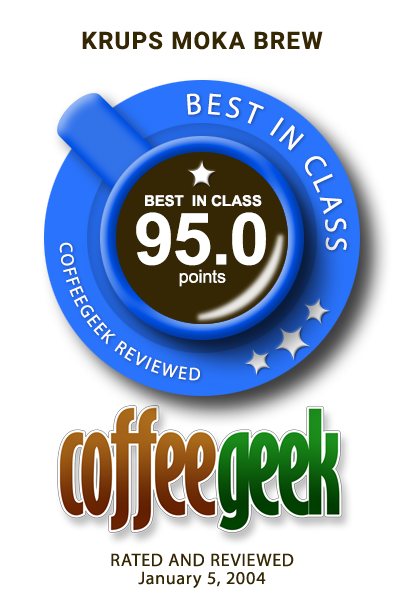
Subscribe to
Coffee Pulse
Delivered twice monthly, CoffeeGeek's premier newsletter dives into a specific coffee topic each issue. The Pulse also occasionally features contests and giveaways. Subscribing is free, and your personal information is never shared.
By submitting this form, you are consenting to receive marketing emails from: CoffeeGeek. You can revoke your consent to receive emails at any time by using the SafeUnsubscribe® link, found at the bottom of every email. Emails are serviced by Constant Contact


